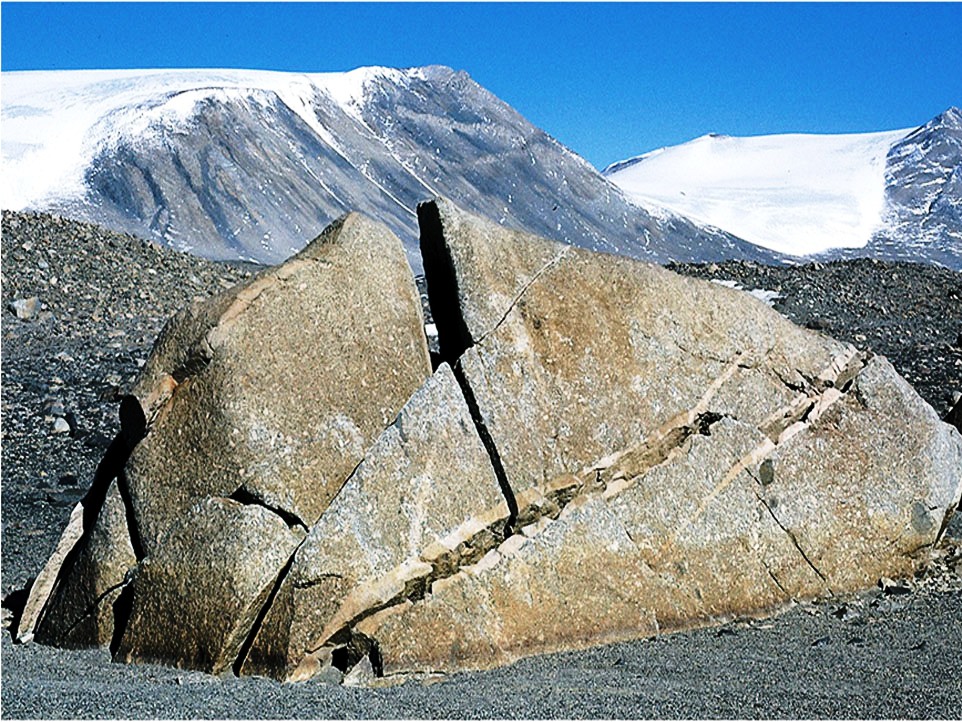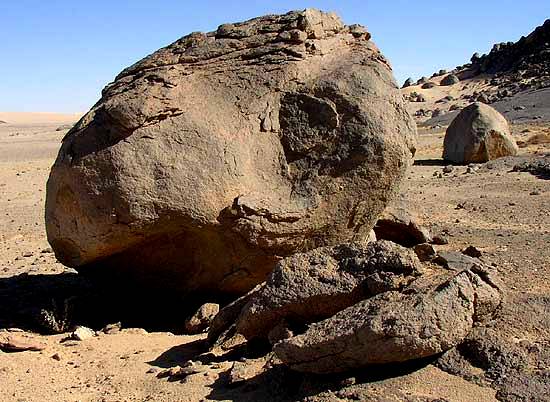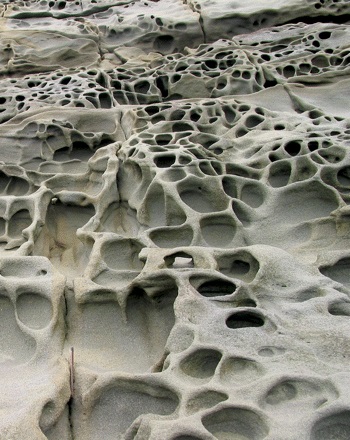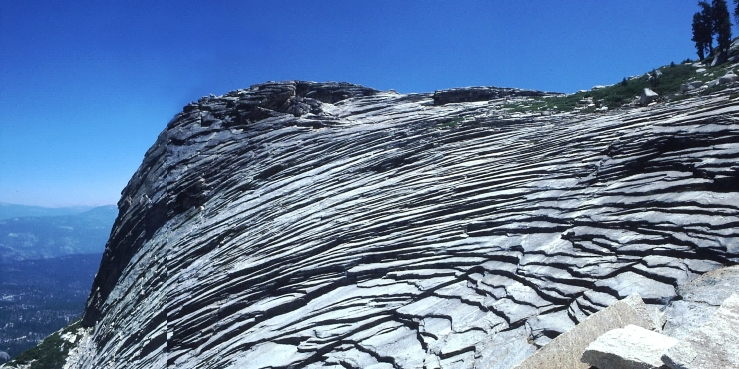
Nesta earthcache iremos abordar o tema da meteorização, mais propriamente sobre a meteorização física. O objectivo passa por conseguir identificar este conceito e realçar a sua importância no ciclo geológico, como responsável pela formação da superfície terrestre e pela alteração dos materiais rochosos.
À medida que afloram as rochas vão adaptando-se às condições existentes à superfície, as quais contrastam em grande escala com as condições a que estavam sujeitas durante a sua génese. O processo pelo qual as rochas se fragmentam e adaptam à superfície da Terra, de forma a procurarem um equilíbrio estável à superfície terrestre é denonimado de meteorização, podendo esta ser dividida em dois tipos: meteorização física e meteorização química, o segundo tipo de meteorização não será objecto de estudo nesta earthcache.
Meteorização Física: neste processo os produtos resultantes apresentam a mesma composição química da rocha original, ocorrendo apenas uma acção mecânica, que leva à fraturação das rochas em fragmentos mais pequenos. Entre os mecanismos inerentes à meteorização física encontram-se: a crioclastia, termoclastia, haloclastia e exfoliação.
Crioclastia: caracteriza-se pela expansão volumétrica da água aquando da sua congelação em espaços confinados, assim a água contida nos poros e nas fracturas das rochas, ao gelar vai sofrer cerca de 9% de expansão, conduzindo a pressões que podem a atingir os 110 Kg/cm2 . Este processo de expansão para além de alargar os poros e fissuras das rochas cria novas descontinuidades, permitindo a infiltração de maior volume de água, meteorizando cada vez mais a rocha. Este processo é bastante comum em locais onde as mudanças bruscas de temperatura atingem o ponto de congelação.

Termoclastia: consiste na alternância de aumentos e diminuições de temperatura, que levam à expansão e contracção das rochas, conduzindo à sua ruptura. Esta meteorização ocorre devido a vários factores entre eles a existência de gradientes de temperatura entre a superfície e o interior da rocha, a diferença entre os coeficientes de expansão térmica dos minerais constituintes e ás amplas variações de temperaturas ambientais. Este mecanismo ocorre preferencialmente em ambientes com grandes amplitudes térmicas, como é o caso dos desertos e zonas de incêndio.

Haloclastia: ocorre através da precipitação de sais dissolvidos na água que circula nas fracturas, que ao ocorrer origina uma força expansiva conduzindo ao desagregar da rocha.

Exfoliação: consiste na separação da rocha por diaclases paralelas à superfície, devidas à descompressão pelo alívio das camadas suprajacentes.

A Cache:
Antes de abordar esta earthcache confira a tabela de maré e a agitação marítima, a realização desta earthcache em dias de condições meteorológicas adversas é totalmente desaconselhada. Aconselho a leitura atenta da listing antes de abordar esta earthcache, pois a leitura antecipada da mesma e a observação das imagens fornecidas, facilita à obtenção do conhecimento necessário para responder as questões seguintes.
1 - Qual o tipo de meteorização física, visível nos bloco rochosos em torno do GZ?
2 - Explique por palavras suas a importância do tipo de meteorização física mencionado por si na resposta anterior, relacionando-o com o depósito de sedimentos de grande extensão na direcção 120º.
Adicionalmente, gostaria de vos pedir que associassem ao vosso log, fotos da vossa visita a esta earthcache, no entanto segundo as guidelines as mesmas são opcionais.
| I have earned GSA's highest level: |
 |

In this earthcache we will approach the theme of weathering, more specifically the physical weathering. The objective is to identify this concept and to emphasize its importance in the geological cycle, as responsible for the formation of the terrestrial surface and the alteration of the rocky materials.
When a rock reach the surface, it adapts to the existing conditions on the surface, which contrast in a large scale with the conditions to which it was subjected during it genesis. The process that leads to the fragment of the rock and it adaption to the surface of the Earth in order to seek a stable equilibrium, is denoted by weathering, which can be divided into two types: physical weathering and chemical weathering, the second type of weathering will not be the object of study in this earthcache.
Physical Weathering:In this process the resulting products have the same chemical composition of the original rock, occurring only a mechanical action, which leads to the fracturing of the rocks into smaller fragments. Among the mechanisms inherent to physical weathering are: cryoclasty, thermoclasty, haloclasty and exfoliation.
Crioclasty: is characterized by the volumetric expansion of the water when it frozen in confined spaces. The water contained in the pores and fractures of the rocks, will suffer about 9% expansion during the freezing , leading to pressures that can reach 110 kg / Cm2. This process of expansion, besides the enlarging of the pores and rock's fissures, creates new discontinuities, allowing the infiltration of a larger volume of water, meteorizing the rock more and more. This process is quite common in places where sudden changes in temperature reach the freezing point.

Termoclasty: consists in the alternation of increases and decreases in temperature, which lead to the expansion and contraction of the rocks, leading to their rupture. This weathering occurs due to growth factors between the surface and the interior of the rock, due to the difference between the coefficients of thermal expansion of the constituent minerals and the wide variations of ambient temperatures. This mechanism occurs preferentially in environments with large thermal amplitudes, like the case of deserts and fire zones.

Haloclasty: occurs due to the precipitation of dissolved salts in the water that circulates in the fractures, when it occurs originates an expansive force leading to the disintegration of the rock. Haloclasty often occurs in coastal areas.

Exfoliation: occurs as cracks develop parallel to the land surface a consequence of the reduction in pressure during uplift and erosion.

The Cache:
Before approaching this earthcache check out the tide table and the undulation, the realization of this earthcache on days of adverse weather conditions is not advised. I advise the reading of the listing before approaching this earthcache, since the anticipated reading of it and the observation of the provided images, facilitates to obtain the knowledge necessary to answer the following questions.
1 - What kind of physical weathering is visible on the rocky block where you are on?
2 -Explain in your words the importance of the type of physical weathering mentioned by you in the previous answer, relating it to the long sediment deposit visible in the 120º direction.
Additionally, I would like to ask you to associate with your log, photos of your visit to this earthcache, however according to the guidelines they are optional.
| I have earned GSA's highest level: |
 |